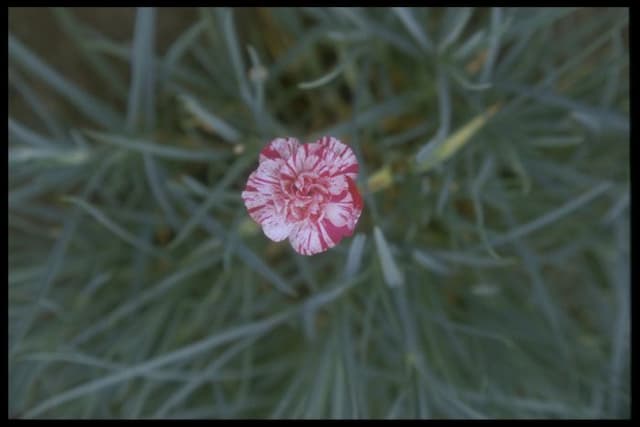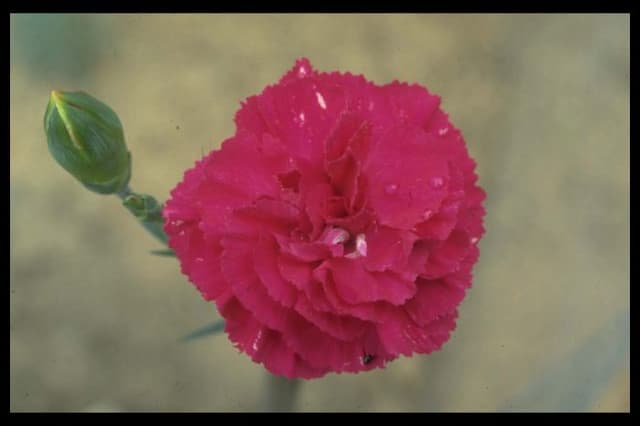Pinks Dianthus 'Brilliant Star' (p)

ABOUT
The Dianthus 'Brilliant Star' is a lovely, flowering garden plant known for its showy blooms and pleasant fragrance. It has narrow, green leaves that form a neat and compact mound, providing a lush backdrop for the vibrant flowers. The blooms themselves are eye-catching, with a vivid pink shade that stands out beautifully. Each petal is fringed on the edge, giving the flowers a slightly ruffled look that adds to their charm. At the center of each flower, there is often a deeper pink or red hue, creating a striking contrast and drawing attention to the vibrant coloration. The blooms are known to be quite rich in scent, perfuming the surrounding area with a delightful, slightly spicy fragrance that is characteristic of many in its family. Overall, Dianthus 'Brilliant Star' is prized in gardens for its striking color, delightful scent, and the ability to add a brilliant pop of color to any planting.
About this plant
 Names
NamesSynonyms
Pinks, Sweet William.
Common names
Dianthus 'Brilliant Star'.
 Toxicity
ToxicityTo humans
The Dianthus, commonly known as Carnation or Pinks, is not considered to be toxic to humans. There are no significant toxic effects reported for Dianthus 'Brilliant Star' if ingested by humans. However, sensitive individuals might experience mild irritation in the skin or stomach if they handle or ingest significant amounts of the plant.
To pets
The Dianthus, commonly known as Carnation or Pinks, is also generally considered to be non-toxic to pets. There is no widespread documentation of toxicity in animals such as cats and dogs from ingesting this plant. Nonetheless, pets may still experience mild gastrointestinal upset if they consume large amounts of the plant, but serious symptoms are unlikely.
 Characteristics
CharacteristicsLife cycle
Perennials
Foliage type
Evergreen
Color of leaves
Blue-green
Flower color
Pink
Height
0 feet 10 inches (25 cm)
Spread
0 feet 12 inches (30 cm)
Plant type
Herb
Hardiness zones
7
Native area
Europe
Benefits
 General Benefits
General Benefits- Attractive Flowers: Dianthus 'Brilliant Star' produces vibrant, pinkish-red flowers with a distinctive, frilled edge that adds a splash of color to any garden or landscape.
- Long Blooming Period: This variety is known for its extended blooming season, which can last from late spring through early fall with proper care.
- Fragrance: The flowers emit a pleasant, spicy clove-like fragrance which can be enjoyed in both garden settings and as cut flowers in the home.
- Drought Tolerance: Once established, Dianthus 'Brilliant Star' has a degree of drought resistance, making it suitable for gardens in drier climates or water-wise landscapes.
- Easy to Grow: This plant is relatively low-maintenance, requiring minimal care beyond occasional watering and deadheading to promote further blooming.
- Pollinator Friendly: The flowers attract a variety of pollinators, including bees and butterflies, contributing to the health of the local ecosystem.
- Compact Size: Its compact growth habit makes it an excellent choice for borders, rockeries, and containers where space may be limited.
- Deer Resistance: Dianthus 'Brilliant Star' is known to be deer resistant, which is an advantage in areas where deer predation on gardens is a problem.
- Cut Flowers: The blooms hold up well when cut, making them ideal for bouquets and floral arrangements.
- Versatility: Suitable for a range of garden styles from cottage to contemporary, adding versatility to its planting applications.
 Medical Properties
Medical PropertiesThis plant is not used for medical purposes.
 Air-purifying Qualities
Air-purifying QualitiesThis plant is not specifically known for air purifying qualities.
 Other Uses
Other Uses- Carnation 'Brilliant Star' petals can be used to create a natural dye for fabrics, providing a range of colors from pale yellow to green depending on the mordant used.
- The flowers are edible and can be used to add color and a spicy flavor to salads or as a garnish for desserts and cocktails.
- Carnations can be pressed or dried to create lasting floral arrangements, bookmarks, or to be incorporated into papermaking for a decorative touch.
- The sweet fragrance of Carnation 'Brilliant Star' can be used in potpourris or sachets to freshen drawers and closets.
- Petals can be infused in oils to capture the scent, which can then be used in homemade perfumes or scented candles.
- If grown in large quantities, carnations can be used as a natural pest deterrent in gardens, as some pests dislike their fragrance.
- The strong stems of Carnations make them ideal for use in floral foam arrangements, helping to stabilize other flowers.
- Carnation blooms can be used to create botanical prints on paper or fabric, by hammering the fresh flowers to release their color.
- Dried Carnation petals can be incorporated into homemade soaps for exfoliation and their aesthetic and aromatic qualities.
- The scent of Carnation 'Brilliant Star' can be captured in homemade potpourri blends, combined with other dried flowers and spices.
Interesting Facts
 Feng Shui
Feng ShuiThe plant Carnation is not used in Feng Shui practice.
 Zodiac Sign Compitability
Zodiac Sign CompitabilityThe plant Carnation is not used in astrology practice.
 Plant Symbolism
Plant Symbolism- Love: Dianthus flowers are traditionally associated with love due to their vibrant and long-lasting blooms.
- Admiration: The bright and striking appearance of 'Brilliant Star' often signifies deep admiration and fascination.
- Boldness: The 'Brilliant Star' variety, with its conspicuous and vivid color, symbolizes boldness and stepping out with confidence.
- Purity: The clean and clear hues of the Dianthus 'Brilliant Star' are often connected with the concept of purity and innocence.
- Affection: Gifting these flowers can signify a strong affection towards someone, as they evoke a comforting and warm feeling.
 Water
WaterThe Carnation, also known as the Dianthus 'Brilliant Star', should be watered deeply but infrequently to encourage strong root growth. Generally, it should be watered once a week with about 1 inch of water, which translates to approximately 0.6 gallons per square foot. During hot or dry spells, watering frequency should be increased to twice a week, ensuring the soil is moist but not waterlogged. Always check that the top inch of soil is dry before watering again. Overwatering can lead to root rot, so it's essential to ensure good drainage and avoid leaving the plant in standing water.
 Light
LightCarnations prefer full sun conditions and will thrive when situated in a place that receives at least 6 to 8 hours of direct sunlight daily. The best spot for the Dianthus 'Brilliant Star' is in an area that offers bright and unfiltered sunlight throughout the day. If grown indoors, a south-facing window is an ideal location to provide the light levels this plant requires for optimal growth and flowering.
 Temperature
TemperatureCarnations grow best in cooler temperatures and can tolerate a range from 40°F to 85°F. The ideal temperature range for Dianthus 'Brilliant Star' is between 60 and 70°F. They can survive light frosts, but prolonged exposure to temperatures below 40°F or above 85°F can be detrimental to the plant's health. Ensuring proper air circulation can help mitigate temperature extremes.
 Pruning
PruningCarnations should be pruned to promote bushy growth and to remove spent blooms, which encourages further flowering. For the Dianthus 'Brilliant Star', deadheading or cutting off the faded flowers should be done regularly during the blooming season. Pruning should also include cutting back the stems by one-third after the first flush of blooms has finished, usually in late spring or early summer. A light pruning in the fall helps maintain the shape and health of the plant.
 Cleaning
CleaningAs needed
 Soil
SoilThe Sweet William prefers well-draining and slightly alkaline soil with a pH between 6.75 and 7.5. A good soil mix for Sweet William can be made by combining two parts loam, one part sand or perlite, and one part compost or well-rotted manure to enrich the soil and improve drainage.
 Repotting
RepottingSweet William typically doesn't require frequent repotting and can often be left for several years unless the plant has outgrown its container. Repotting can be done in the spring or autumn if necessary.
 Humidity & Misting
Humidity & MistingSweet William thrives in average humidity levels and does not require any special humidity conditions. The plant is quite adaptable and can tolerate the humidity levels found in most home and garden environments.
 Suitable locations
Suitable locationsIndoor
Provide full sun by placing in a south-facing window.
Outdoor
Plant in full sun to partial shade in fertile soil.
Hardiness zone
3-9 USDA
 Life cycle
Life cycleThe Dianthus 'Brilliant Star', commonly known as Pinks, begins its life cycle as a seed, which germinates in warm, well-drained soil usually in late winter to spring. After germination, it develops into a seedling, where the plant establishes its roots and produces its first sets of true leaves. As it matures into a young plant during spring to early summer, it experiences vegetative growth, establishing a rosette of blue-green foliage. During late spring through summer, the Dianthus 'Brilliant Star' enters the flowering stage, producing vibrant pink to red flowers with frilled edges, a stage that is vital for pollination and seed production. After blooming, it sets seed which can be collected for propagation or left to self-sow in the garden. Throughout the growing season, the plant may enter a period of dormancy, especially in colder climates, and with proper care and conditions, it may re-emerge the following spring to repeat the life cycle.
 Propogation
PropogationPropogation time
Spring-Early Summer
Propogation: Dianthus 'Brilliant Star', commonly known as Pinks, is best propagated through cuttings. This method is popular due to its ease and effectiveness. The ideal time to take cuttings is late spring through early summer when the plant is actively growing. To propagate Pinks, select a healthy stem that has not flowered and cut a 3-4 inch (approximately 7.5-10 cm) length, making sure the cutting has a few leaf nodes. Remove the lower leaves, dip the cut end in rooting hormone, and insert it into a well-draining growing medium such as a mix of perlite and peat. The cutting should be kept in a warm, bright spot but out of direct sunlight and maintained consistently moist until roots have developed and new growth is visible, usually within a few weeks. Once the cuttings have established a good root system, they can be transplanted to their final location.




![Pink [Coconut Sundae]](/_next/image?url=https%3A%2F%2Fplants-admin.emdemapps.com%2Fimages%2Fplants%2F%2Fimages%2F604b5d09d4fd1.png&w=640&q=75)




